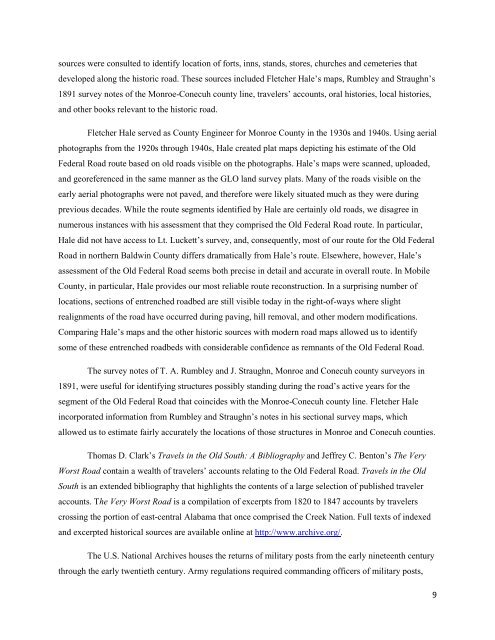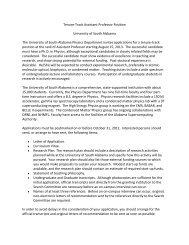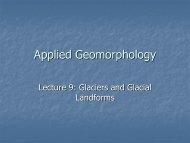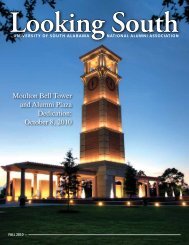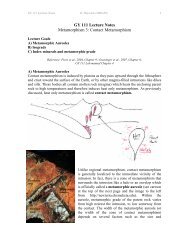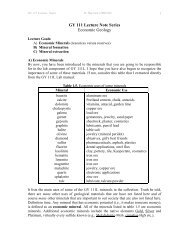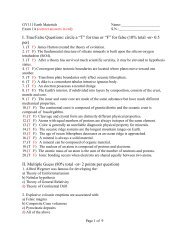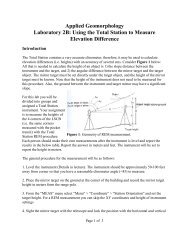Archaeological Survey of the Old Federal Road in Alabama
Archaeological Survey of the Old Federal Road in Alabama
Archaeological Survey of the Old Federal Road in Alabama
Create successful ePaper yourself
Turn your PDF publications into a flip-book with our unique Google optimized e-Paper software.
sources were consulted to identify location <strong>of</strong> forts, <strong>in</strong>ns, stands, stores, churches and cemeteries thatdeveloped along <strong>the</strong> historic road. These sources <strong>in</strong>cluded Fletcher Hale’s maps, Rumbley and Straughn’s1891 survey notes <strong>of</strong> <strong>the</strong> Monroe-Conecuh county l<strong>in</strong>e, travelers’ accounts, oral histories, local histories,and o<strong>the</strong>r books relevant to <strong>the</strong> historic road.Fletcher Hale served as County Eng<strong>in</strong>eer for Monroe County <strong>in</strong> <strong>the</strong> 1930s and 1940s. Us<strong>in</strong>g aerialphotographs from <strong>the</strong> 1920s through 1940s, Hale created plat maps depict<strong>in</strong>g his estimate <strong>of</strong> <strong>the</strong> <strong>Old</strong><strong>Federal</strong> <strong>Road</strong> route based on old roads visible on <strong>the</strong> photographs. Hale’s maps were scanned, uploaded,and georeferenced <strong>in</strong> <strong>the</strong> same manner as <strong>the</strong> GLO land survey plats. Many <strong>of</strong> <strong>the</strong> roads visible on <strong>the</strong>early aerial photographs were not paved, and <strong>the</strong>refore were likely situated much as <strong>the</strong>y were dur<strong>in</strong>gprevious decades. While <strong>the</strong> route segments identified by Hale are certa<strong>in</strong>ly old roads, we disagree <strong>in</strong>numerous <strong>in</strong>stances with his assessment that <strong>the</strong>y comprised <strong>the</strong> <strong>Old</strong> <strong>Federal</strong> <strong>Road</strong> route. In particular,Hale did not have access to Lt. Luckett’s survey, and, consequently, most <strong>of</strong> our route for <strong>the</strong> <strong>Old</strong> <strong>Federal</strong><strong>Road</strong> <strong>in</strong> nor<strong>the</strong>rn Baldw<strong>in</strong> County differs dramatically from Hale’s route. Elsewhere, however, Hale’sassessment <strong>of</strong> <strong>the</strong> <strong>Old</strong> <strong>Federal</strong> <strong>Road</strong> seems both precise <strong>in</strong> detail and accurate <strong>in</strong> overall route. In MobileCounty, <strong>in</strong> particular, Hale provides our most reliable route reconstruction. In a surpris<strong>in</strong>g number <strong>of</strong>locations, sections <strong>of</strong> entrenched roadbed are still visible today <strong>in</strong> <strong>the</strong> right-<strong>of</strong>-ways where slightrealignments <strong>of</strong> <strong>the</strong> road have occurred dur<strong>in</strong>g pav<strong>in</strong>g, hill removal, and o<strong>the</strong>r modern modifications.Compar<strong>in</strong>g Hale’s maps and <strong>the</strong> o<strong>the</strong>r historic sources with modern road maps allowed us to identifysome <strong>of</strong> <strong>the</strong>se entrenched roadbeds with considerable confidence as remnants <strong>of</strong> <strong>the</strong> <strong>Old</strong> <strong>Federal</strong> <strong>Road</strong>.The survey notes <strong>of</strong> T. A. Rumbley and J. Straughn, Monroe and Conecuh county surveyors <strong>in</strong>1891, were useful for identify<strong>in</strong>g structures possibly stand<strong>in</strong>g dur<strong>in</strong>g <strong>the</strong> road’s active years for <strong>the</strong>segment <strong>of</strong> <strong>the</strong> <strong>Old</strong> <strong>Federal</strong> <strong>Road</strong> that co<strong>in</strong>cides with <strong>the</strong> Monroe-Conecuh county l<strong>in</strong>e. Fletcher Hale<strong>in</strong>corporated <strong>in</strong>formation from Rumbley and Straughn’s notes <strong>in</strong> his sectional survey maps, whichallowed us to estimate fairly accurately <strong>the</strong> locations <strong>of</strong> those structures <strong>in</strong> Monroe and Conecuh counties.Thomas D. Clark’s Travels <strong>in</strong> <strong>the</strong> <strong>Old</strong> South: A Bibliography and Jeffrey C. Benton’s The VeryWorst <strong>Road</strong> conta<strong>in</strong> a wealth <strong>of</strong> travelers’ accounts relat<strong>in</strong>g to <strong>the</strong> <strong>Old</strong> <strong>Federal</strong> <strong>Road</strong>. Travels <strong>in</strong> <strong>the</strong> <strong>Old</strong>South is an extended bibliography that highlights <strong>the</strong> contents <strong>of</strong> a large selection <strong>of</strong> published traveleraccounts. The Very Worst <strong>Road</strong> is a compilation <strong>of</strong> excerpts from 1820 to 1847 accounts by travelerscross<strong>in</strong>g <strong>the</strong> portion <strong>of</strong> east-central <strong>Alabama</strong> that once comprised <strong>the</strong> Creek Nation. Full texts <strong>of</strong> <strong>in</strong>dexedand excerpted historical sources are available onl<strong>in</strong>e at http://www.archive.org/.The U.S. National Archives houses <strong>the</strong> returns <strong>of</strong> military posts from <strong>the</strong> early n<strong>in</strong>eteenth centurythrough <strong>the</strong> early twentieth century. Army regulations required command<strong>in</strong>g <strong>of</strong>ficers <strong>of</strong> military posts,9


